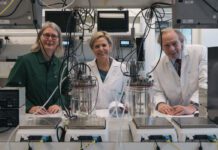
PFAS (per-and polyfluoroalkyl substances), a group of more than 4,700 fully synthetic compounds that are widely used in industrial and manufacturing processes and found in many consumer products, persist through wastewater treatment at levels that may impact the long-term feasibility of “beneficial reuse of treated wastewater,” according to a study conducted by researchers at Penn State and recently published in the Agronomy Journal.
PFAS, often referred to as “forever chemicals,” are used to make fluoropolymer coatings and products that resist heat, oil, stains, grease and water, and are found in a variety of products from clothing and furniture to food packaging and non-stick cooking surfaces.
“PFAS are so pervasive and persistent that they have been found in the environment all over the world, even in remote locations,” said Heather Preisendanz, associate professor of agricultural and biological engineering at Penn State. “Unfortunately, these compounds have been shown to negatively impact ecological and human health, particularly because they can bioaccumulate up the food chain and affect development in children, increase risk of cancer, contribute to elevated cholesterol levels, interfere with women’s fertility and weaken immune systems.”
Because of their wide variety of uses, PFAS enter wastewater treatment plants from both household and industrial sources, said Preisendanz.
Beneficial reuse of treated wastewater is an increasingly common practice in which treated wastewater is used for irrigation and other non-potable purposes. According to Preisendanz, this practice provides an opportunity for the soil to act as an additional filter for PFAS, reducing the immediate impact of direct discharge of PFAS to surface water, as would typically happen following traditional wastewater treatment. However, given that the chemical structures of PFAS are difficult to degrade, the risks and potential tradeoffs of using treated wastewater for irrigation practices, especially in the long-term, are not well understood.
“PFAS have been shown to be taken up by crops and enter the food chain when the crops are consumed, so when treated wastewater is used for irrigation activities in agricultural fields, understanding these tradeoffs is of critical importance,” she said.
Preisendanz and her colleagues analyzed PFAS concentrations in water that passed through a water reclamation facility. They collected bi-monthly water samples from fall 2019 through winter 2021 prior to treatment and after treatment. Since the treated water from the wastewater treatment plant is used to irrigate nearby crops, the team also collected tissues from those crop plants, including corn silage and tall fescue, to assess for the presence of PFAS.
The team identified 10 types of PFAS across the site, with average total measured concentrations of 88 ng/L in the wastewater effluent and concentrations as high as 155 ng/L (nanograms per liter) in the downstream monitoring wells. The conclusions suggest that occurrence of PFAS across the site is nearly ubiquitous, and that levels increase with the direction of groundwater flow.
“The United States Environmental Protection Agency recently released updated health advisories for two of the most important PFAS — PFOA (Perfluorooctanoic acid) and PFOS (Perfluorooctanesulfonic acid) — such that ‘any detectable level is considered a risk to human health,’” said Preisendanz. “This presents potential challenges for beneficial reuse of wastewater.”
While the groundwater near the spray-irrigation site the team studied is not used for drinking, and not likely to pose a risk to human health in that regard, the team did find several PFAS compounds in crop tissue samples collected at both irrigated and non-irrigated portions of the site.
“This suggests that PFAS may enter the food chain when these crops are fed to livestock,” Preisendanz said, adding that future research is needed to determine potential risks to livestock health and the potential implications of PFAS presence in meat and dairy products, including milk. “Our study results have important implications to ensure that beneficial wastewater reuse activities achieve desired goals to reuse water and nutrients, while simultaneously ensuring PFAS levels are safe from a human health perspective.”
Other Penn State authors on the paper include Olivia Mroczko, graduate student in agricultural and biological engineering ; Christopher Wilson, former graduate student in agricultural and biological engineering; Michael L. Mashtare, assistant professor of agricultural and biological engineering; Herschel A. Elliott, professor emeritus of agricultural and biological engineering; Tamie L. Veith, agricultural engineer, USDA-ARS pasture systems and watershed management research unit; Kathy J. Soder, animal scientist, USDA-ARS pasture systems and watershed management research unit; and John E. Watson, professor of soil science.
This research was funded, in part, by the Penn State Office of the Physical Plant, the USDA Agricultural Research Service, the U.S. Environmental Protection Agency, the USDA National Institute of Food and Agriculture and the Penn State Institutes of Energy and the Environment.






